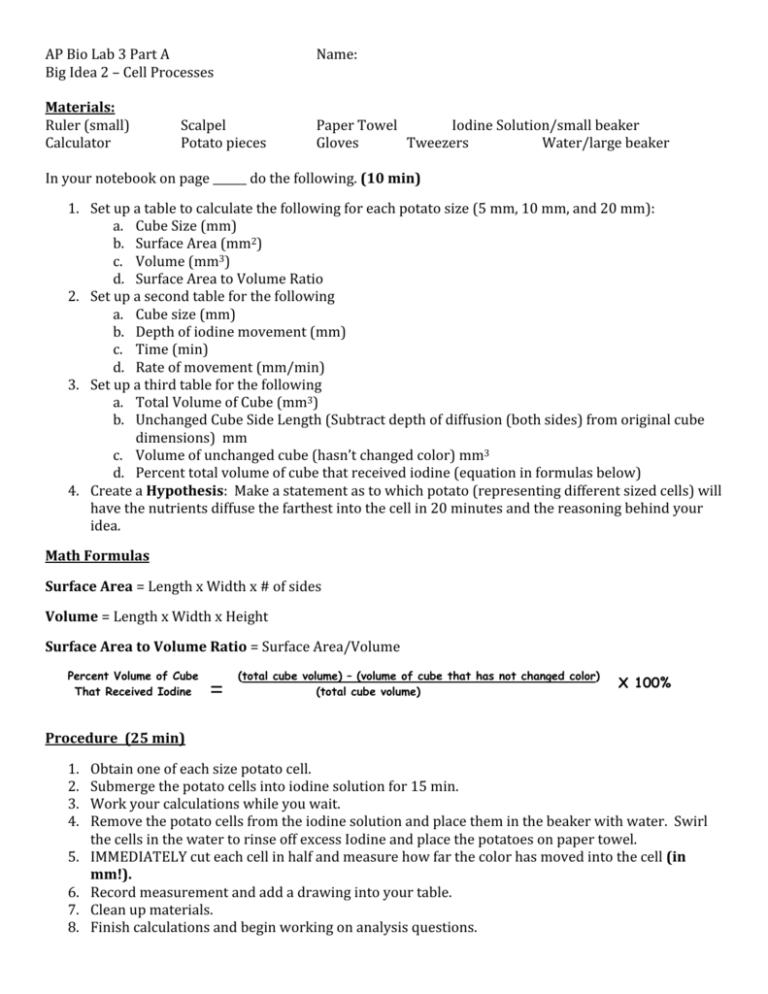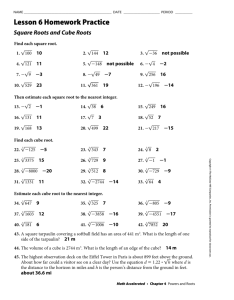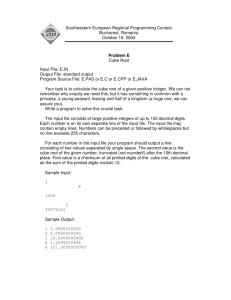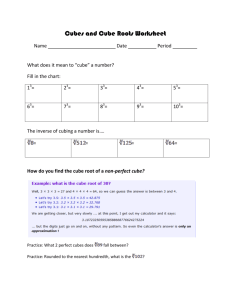AP Bio Lab 3 Part A Name: Big Idea 2 – Cell Processes Materials: R
advertisement

AP Bio Lab 3 Part A Name: Big Idea 2 – Cell Processes Materials: Ruler (small) Scalpel Paper Towel Iodine Solution/small beaker Calculator Potato pieces Gloves Tweezers Water/large beaker In your notebook on page ______ do the following. (10 min) 1. Set up a table to calculate the following for each potato size (5 mm, 10 mm, and 20 mm): a. Cube Size (mm) b. Surface Area (mm2) c. Volume (mm3) d. Surface Area to Volume Ratio 2. Set up a second table for the following a. Cube size (mm) b. Depth of iodine movement (mm) c. Time (min) d. Rate of movement (mm/min) 3. Set up a third table for the following a. Total Volume of Cube (mm3) b. Unchanged Cube Side Length (Subtract depth of diffusion (both sides) from original cube dimensions) mm c. Volume of unchanged cube (hasn’t changed color) mm3 d. Percent total volume of cube that received iodine (equation in formulas below) 4. Create a Hypothesis: Make a statement as to which potato (representing different sized cells) will have the nutrients diffuse the farthest into the cell in 20 minutes and the reasoning behind your idea. Math Formulas Surface Area = Length x Width x # of sides Volume = Length x Width x Height Surface Area to Volume Ratio = Surface Area/Volume Percent Volume of Cube That Received Iodine = (total cube volume) – (volume of cube that has not changed color) (total cube volume) X 100% Procedure (25 min) 1. 2. 3. 4. 5. 6. 7. 8. Obtain one of each size potato cell. Submerge the potato cells into iodine solution for 15 min. Work your calculations while you wait. Remove the potato cells from the iodine solution and place them in the beaker with water. Swirl the cells in the water to rinse off excess Iodine and place the potatoes on paper towel. IMMEDIATELY cut each cell in half and measure how far the color has moved into the cell (in mm!). Record measurement and add a drawing into your table. Clean up materials. Finish calculations and begin working on analysis questions. Analysis Questions – answer on left page next to data. 1. 2. 3. 4. As your cell size increases, which increases faster: cell surface area or cell volume? What trend do we see in the surface area to volume ration as cell size increases? If iodine was a substance needed within the cell, what problem(s) would the largest cell have? According to your data, which cell is most successful at receiving the needed nutrient in the allowed time? What can you say about the surface to volume ratio that will best meet the needs of living cells? How could the potato’s (cell’s) shape affect the rate of the movement of iodine? Based on your observations, why are cells microscopic? Reevaluate your hypothesis. Change it as needed. 5. 6. 7. 8. Graph: Graph the percent volume of cube changed by cell size (5, 10, 20mm). Title: Predict: What would the Percent Volume of Cube Changed for the following cubes: a. 2.5 mm b. 40 mm c. 15 mm





